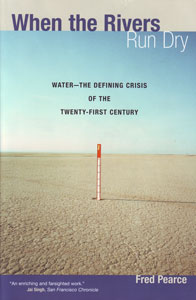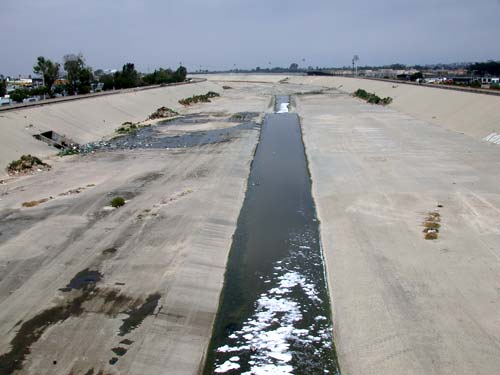When the rivers run dry
Share
A review of Pearceís assessment of the worldís water resources
by Barbara Rodgers-Hendricks, Green Party of Florida
ìWhen the rivers run dry, we mine our childrenís water.î Fred Pearce
 It is no surprise that as a long-time investigator on water, Fred Pearce traveled to more than 30 countries to examine the state of their water sources in researching for his current book, ìWhen the Rivers Run Dry.î Pearce begins his book with the heavy water ìfoot printî of western countries on the rest of the world. Conserving water is definitely needed he said, but the problem is larger. The entire approach to water management must be changed.
It is no surprise that as a long-time investigator on water, Fred Pearce traveled to more than 30 countries to examine the state of their water sources in researching for his current book, ìWhen the Rivers Run Dry.î Pearce begins his book with the heavy water ìfoot printî of western countries on the rest of the world. Conserving water is definitely needed he said, but the problem is larger. The entire approach to water management must be changed.
Fred Pearce has been writing about water issues for more than 20 years. He is currently consultant for ìNew Scientistî and his books include ìWith Speed and Violence,î ìTurning Up the Heat,î and ìDeep Jungle.î Pearceís readable style of writing has kept his writing in demand from periodicals such as ìAudubon,î ìPopular Science,î ìTime,î ìThe Boston Globe,î and ìNatural History.î
Each of the ten chapters in the book begins with the phrase ìWhen the rivers run dry Ö ì and completes the sentence by saying ìthe crops fail, we mine our childrenís water, the wet places dieî and so on. His final two chapters observe that when the rivers run dry, we try to catch the rain, and we go with the flow.
Pearce first looks at the Rio Grande River. It flows through Colorado, New Mexico, Mexico, Texas, and is barely a trickle by the time it gets to the sea. Human exploitation via the Elephant Butte Reservoir and wasteful irrigation is the problem. This story is repeated in many countries. Pakistan is a prime example of the perils of the overuse of water for irrigation. When fields become waterlogged, salts in the ground are dissolved and rise to the surface. The result is salt-encrusted fields, which are unproductive.
Throughout the world, massive dams have been built to produce electricity. The rivers, which would naturally overflow their banks and leave fertile silt in the floodplains, are forced into direct routes. When the dams prevent the natural ebb and flow of the rivers, pervious fertile farmland is turned into deserts and severe floods occur in other places, destroying everything in their wake. Because of the damming of the rivers, diverting of their courses, and over-irrigation along the way, the rivers are dying.
The Rio Grande is just one of many great rivers which are trickling into the sand, some of them hundreds of miles before they reach the sea. Other rivers which share the same fate are the Nile in Egypt, the Yellow River in China, the Indus in Pakistan, and the Colorado in the U.S. Israel is draining the Jordan River into pipes before it reaches Jordan. The Ganges is running dry, and the Oxus in Central Asia has been diverted into the desert.
When the rivers run dry, farmers and others, sink wells to provide water for drinking and irrigation. But they have to dig deeper as the aquifers are drained. Sometimes, as in India, Pakistan, Kashmir, and China, the wells have produced poisoned water containing high levels of fluoride and arsenic.
The book asks what is to be done about the water crisis encompassing the entire globe? There seems to be small rays of hope in several areas.
Dewponds, neglected for generations, are coming back into favor. Also called fog catchers, dewponds capture water from the air. A hilltop location is key, because air cools as it rises and, since cold air can hold less water, the water condenses into clouds or fogs. Ancient sheepherders and farmers have dug ponds to capture the tiny droplets of water from clouds, fogs, and dew. To make the dewponds as efficient as possible, workers provided cool surfaces by putting straw the beneath the clay and stones on top. The straw insulates the clay, keeping it cooler than the ground beneath at night. The stones shed heat quickly when the sun goes down and lower the temperature even faster, thus facilitating the condensation. Good dewponds have lasted for generations and are again being built and utilized.
Coaxing water from clouds by sound waves is a method enjoying some success. It gives credence to the rain dances of the native peoples who stomped the ground and beat on drums in their rain dances. The sound waves created in this manner may have brought on the rain. Some countries such as India and Africa are seeding clouds. Also particularly in China, India, the Middle East and Africa, communities are harvesting rain with rain barrels.
Quanats, an ancient form of underground aqueduct, may help in the water crisis, especially in the Middle East, Central Asia, and North Africa. In these regions, rain falls sporadically and mostly in the mountains where water swiftly percolates underground. Persian engineers 3000 years ago tapped into this water source building the first quanats in Iran by drilling horizontal tunnels back into the hillside. In Yemen they are called ìunfailing streamsî because they are self-regulating ñ tapping the aquifers only to the limit of natural replenishment. Quantas are presently being excavated and repaired.
Soft engineering, going with the flow of nature, is advocated in many countries. Banks, dams, and levees are being torn down to give rivers back their floodplains and their natural, meandering path to the sea.
Pearce urges a new water ethic, which will harness modern technology while respecting nature and making clean water available to all earthís inhabitants. ìWhen the Rivers Run Dryî is well worth reading for anyone serious about sustainable human existence on the earth.

Tijuana River, Mexico | photo by David Doonan




